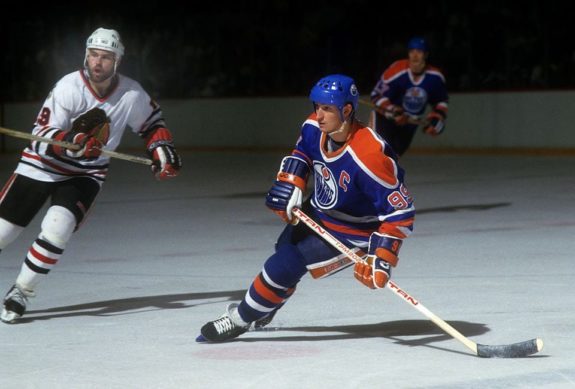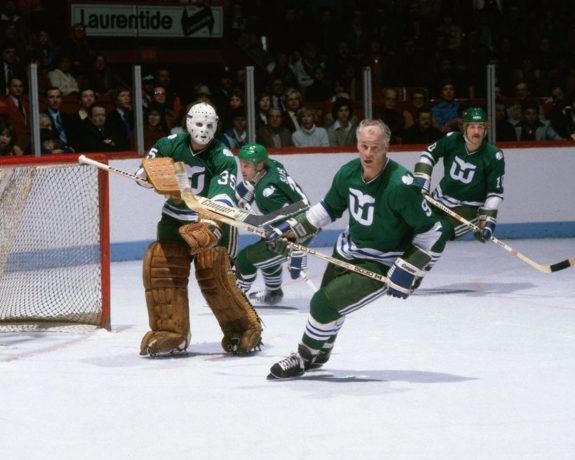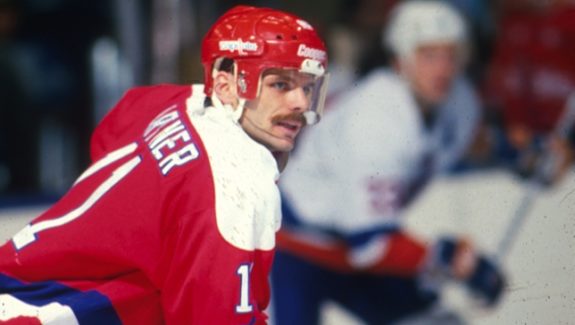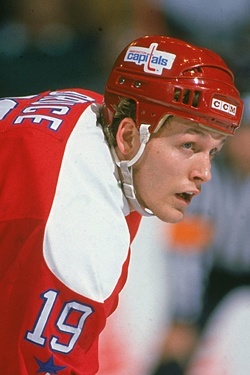Being a hockey fan in the Washington area during the 1980s was a much different experience that it is today.
While fans today have the choice of watching the majority of games on television or the internet, back during the 1983-84 regular season they could watch just 15 games on local television, and all road contests were on broadcast television produced by crews in Canada.
For that season, the team used legendary Montreal Canadiens broadcaster Danny Gallivan for the limited amount of games broadcast locally on WDCA-TV Channel 20, unless other games were broadcast by USA Network, the league’s national broadcast home at the time. That small slice of schedule was all fans got on television, and with Washington’s limited national reach, over three-quarters of the schedule called on relying on Ron Weber’s radio broadcasts on WTOP or even calling into George Michael Sports Machine’s phone number for scores on the road.
Previous years in the 1980s saw Jim West of WBAL radio in Baltimore calling the limited games on WDCA, but there was no real permanent play-by-play television voice, unlike the radio side where Weber called the games for radio since the team’s inception.
As a result, those wanting to see home games were limited to who bought tickets and made the trip to the Capital Centre, save a rare telecast from Landover on national cable.
That all changed on April 4, 1984, when the team finally got its own identity on television with the launch of Home Team Sports, a regional sports network that eventually became Comcast SportsNet and the NBC Sports Washington feed that still broadcasts all regular-season games that aren’t on national television. This is a far cry from the small percentage of games available that were on TV 38 years ago.
Originally, the network was supposed to begin broadcasting with the defending World Series Champion Baltimore Orioles, but their scheduled game against the Chicago White Sox was rained out. Instead, the Capitals’ 1984 playoff opener against the Philadelphia Flyers ended up being the first game ever broadcast on the new cable network.
The launch of the network changed the way fans could watch the Capitals. It also opened the sport up to households around the region stretching from Pennsylvania to North Carolina, and came at a time when the franchise was beginning to become a Stanley Cup threat after years of languishing out of the postseason.
Finding a Voice for the Capitals
The first thing Home Team Sports had to do was find a permanent television voice, as while Gallivan had done the road games that year, he wouldn’t be available for a more rigorous schedule with Montreal also in the postseason.
When the network landed Gordie Howe to do color commentary for those initial Capitals games, it also started the process to bring in Mike Fornes, who eventually became a familiar voice for hockey fans in the Washington area for the rest of the decade.
Fornes, who called Wayne Gretzky‘s first WHA goal in Indianapolis in 1978 against Edmonton, had been doing Hartford Whalers games since 1981 for PRISM New England, and later SportsChannel New England, until he got a call out of the blue in March of 1984 while the Whalers were on a road trip. The message was left in a Canadian hotel for him to call back, and he was offered the job for the network’s first NHL broadcasts.

“As the broadcaster for the Whalers for three years, I was on television, and every minor-league job that I had gotten as well as the Whalers, those involved sending tapes and resumes and making contacts and hoping to get that break,” Fornes recalled recently in a phone interview. “Thing with the Capitals, I didn’t apply to the Capitals. The Capitals came to me, and it was because they were just starting their deal with Home Team Sports, and really they needed someone to do the playoffs.”
“Hartford wasn’t going to be in the playoffs, so that’s how I got that chance. I was in a hotel in Edmonton, there were probably a couple of games left [in Hartford’s season], and I remember being told in a phone message that I needed to call Washington. The thing was they just hired Gordie Howe to do the color commentary for these playoff games. … Because Gordie was going to do the color, it made sense that the play-by-play guy was available, and there I was. I got the job and worked with Gordie. It was exciting.”
For the Capitals, who had just qualified for the playoffs for the second time in their history after missing the first eight years of the franchise’s existence, it was a memorable debut for the network as Washington defeated the Flyers 4-2 (“Capitals Start Off Right, Defeat Flyers, 4-2,” The Washington Post, 4/5/84) in the playoff opener.
That win opened a three-game sweep of Philadelphia, which was the first-ever playoff series win in Washington’s history. While the Capitals lost in the second round to the four-time Stanley Cup champion New York Islanders, the win over their regional rival certainly was a turning point in the club’s history.
With the team recording its first 100-point campaign in 1983-84, along with their first-ever playoff series win, there was an increased interest in the team, and the Capitals would see the television coverage increase dramatically. With the team to have at least 45 games broadcast on Home Team Sports the next year, 30 at home and 15 on the road, along with 15 games on WDCA, the team went from 15 to 60 regular-season games on television in just one season. And, with Home Team Sports needing a permanent Capitals play-by-play voice, they offered Fornes the job to stay in Washington rather than return to Hartford.

“The Whalers were trying to make their move and become a better team but Washington was a generation ahead of Hartford,” Fornes said. “They had better draft picks, they used them well, they were making some trades and building a team they would up building around certain players. It was a very fun time and the good thing was to jump in and be with the Capitals that next year.”
Al Koken Adds Color to the Booth
While Howe did not return to Home Team Sports, the team needed a color commentator to pair with Fornes, and found a familiar face for Capitals fans today. “Smokin'” Al Koken, who had covered the Capitals in their early days for United Press International, and also had worked for WTOP radio and WTTG Channel 5 locally, got a chance to join the first full season of Capitals hockey on local cable television for the 1984-85 campaign, along with the WDCA road games.
“It was fantastic,” Koken said recently of his pairing with Fornes. “[Mike] taught me so much still to this day, and I can’t thank him enough for. As a non-hockey player doing color commentary, it was a real surprise to many, and I credit Jody Shapiro at Home Team Sports and [Capitals General Manager] David Poile for signing off on it and letting me have the opportunity, and of course the coaches – Bryan Murray was great. My partner had to accept me in that role, and Mike certainly did.”
“I used to have a rule, I used to tell color commentators, this is how I like to do this,” Fornes said of his broadcast style. “When the puck’s on the ice, I’m talking. When the play stops, it’s your turn. I thought that worked really well. They don’t do it that way it now.”
Koken appreciated the clear boundary as he felt it helped the broadcast.
“He had a rule that when the puck was in play, it was his, when it was out of play, it was mine,” Koken said. “I think now you hear color commentators jumping in during the play, so it’s changed a little bit. Mike was very old-school, but it was really good, it set up a good line of demarcation for me, and gave me a comfort zone.”
Koken also laughed as he told another story of learning the ropes as a color commentator in the NHL.
“[Mike] also made sure as a rookie, he made sure I got him his beer before the broadcast,” he said. “The beer was barely consumed, don’t get me wrong, and he wasn’t hammered and I wasn’t working with Harry Caray where, in the second game of a doubleheader in San Francisco, he’d be talking about azure blue skies and somewhat in the bag. This was the way of Mike having a sip to keep the vocal cords going, and he liked the beer.”

The pairing went well, as now-nationally syndicated columnist Norman Chad gave the two good marks in a Washington Post review during the team’s playoff run in 1986.
“As we journey through the NHL’s Stanley Cup playoffs, area viewers can rejoice in a couple of aspects: 1) the Capitals, after years of being pronounced dead on arrival at the postseason party, actually are alive and well, and 2) the local TV coverage of the games has been darn good,” Chad wrote as the paper’s sports media expert at the time (from ‘Sports Waves’, The Washington Post, 4/26/86).
“There isn’t a lot of difference in quality between WDCA-TV-20’s telecasts of Capitals road games and Home Team Sports’ cablecasts of Capitals home games. That’s because the key personnel on both productions is identical — producer Bill Brown, play-by-play broadcaster Mike Fornes and analyst Al Koken.
“Now in their second year together, Fornes and Koken appear exceedingly comfortable with each other. While these two gentlemen often look unsure on how to style their hair, they are cocksure on how to call a hockey game. Fornes and Koken can be criticized for a bias toward the Capitals, but it’s not nearly as bad as you’ll find elsewhere in town, and they generally bring intelligence and insight to a broadcast.
“Fornes, who did Hartford Whalers games before coming here, handles play-by-play in low-key, steady fashion. He’s adept at following the puck with a minimum of words, and he gets excited in all the right spots. Even his signature call — the words ‘ . . . and a goal!!! ‘ — speaks loudly for his quiet, efficient style. Take, for instance, Game 3 of the Capitals-Rangers playoff series. As we watched a breakaway develop to produce Washington’s first goal, Fornes simply told us, ‘Bobby Carpenter — a break. He’s in alone. A deke, a shot… and a goal!!’
“Koken, meanwhile, interjects good analysis without intruding on the game. He plays off his partner well and picks his spots nicely. On replays, he is especially strong — many analysts often just walk us through a replay, simply repeating a play-by-play as we watch, but Koken makes an effort to point out aspects of the play we might have missed that precipitated the goal or the penalty.”
“A Shot… and a Goal!” Became a Signature Call
The one call longtime fans remember of Fornes is that signature goal call. “A shot… and a goal!” was a unique goal call at the time, but it was a phrase he had picked up from a Chicago Blackhawks broadcasting legend growing up in Dayton, Ohio.

“When I was growing up, as a kid, listening to the radio, I used to listen to the Chicago Blackhawks. And Lloyd Pettit was the announcer for the Blackhawks, and he would call a goal that way. He would would say ‘A shot and a goal!’
“As time went on, I would get more people on the radio dial, and I would listen to Dan Kelly in St. Louis and Bob Wilson in Boston, and these were people that I ended up working alongside these people and that was quite a thrill. These other people say ‘He shoots, he scores!’; And eventually I realized the guy who first said that was Foster Hewitt and all these other announcers were copying Foster Hewitt – except Lloyd Pettit.
“So when I was working in the minor leagues, I went to a Blackhawks game, and I met Lloyd Pettit, and I asked him about it, and I said ‘I don’t want to be accused of copying you, but I think I’d be accused of copying Foster Hewitt if I said ‘He shoots he scores!’ And Lloyd told me, go with whatever you feel to express yourself in the moment.
“My first minor league game in Muskegon, the first goal was scored and I said ‘A shot and a goal!’ and that’s how I felt comfortable calling it. Over the years, I varied a little bit in describing goals, but that’s what I used on the really big goals. By the time reached the WHA, Lloyd had retired, so I was the only announcer using that phrase, and when I got to the NHL, I stayed with it, it became my trademark because it was the only one who said it.”
Signature Call in Game 7 vs. Philadelphia
Today’s Capitals fans will recognize that phrase from the signature highlight of that decade for the franchise, Dale Hunter’s overtime goal in Game 7 against Philadelphia in 1988.
“It was a terrific thing,” Fornes recalled of that game. “It pushed the team out of that first round. That team had been built to beat the Flyers. [The Hunter trade] was that trade that was made to do that. … All of the sudden Dale Hunter scored that goal on Ron Hextall and it changed everything. It really gave everyone a reason to believe.”

Koken, who has been around the franchise since its first season, compared those 1980s teams who couldn’t quite get over the hump in the playoffs to the 2018 version who did.
“Bryan [Murray]’s teams always they had an ability to win in a different styles,” Koken said. “They had different personalities. You had the years where they had the four 20-plus goal scorers on the blueline, and you also had the ultimate shutdown guy in Rod Langway.
“We always were saying if only they had an elite goaltender. They had some good goaltenders, Donnie Beaupre was a good goaltender, but if they had a Braden Holtby, an Olie Kolzig, we wouldn’t be looking at this 2018 team as the first one to break through. Bryan Murray was able to get 100-point and 100-point-plus seasons at a time you would only get a point for a tie. When you look back from the general manager to coaching to players on down, those were some quality teams.
“I remember standing of the corner of a game at Madison Square Garden in 1986 and Pierre Larouche with his skates past the goal line, throwing the puck towards the net that deflected off Pete Peeters’ skates to knock the Capitals out of the playoffs and you go ‘How did that go in?’ Pete was a good goaltender – he was great for Philly and good for Washington – but it was always something like that that seemed to get in the way of big success in the playoffs that those teams really deserved.”
“Mike’s legendary call, ‘Murphy finds Hunter, he’s in alone – a shot and a goal!,'” Koken added. “That’s Larry Murphy, who’s ‘whooped whooped whooped’ by fans, and yet who’s in the Hall of Fame. The Capitals had skill guys, and for all of Scott Stevens’ physicality, he was an excellent offensive player, and Al Iafrate, Kevin Hatcher, Sylvain Cote, they had good offensive minded defensemen, and I look at the Capitals team this year, and look at this year, I think it’s been driven by their blueline.
“[Evgeny] Kuznetsov and Ovi have been fantastic but their abitliy to break up ice, they may not have the big goal scorers other than John Carlson that those Capitals teams in the 80s and 90s had, but I think good blueline play drove everything up and allowed the Peter Bondras and Mike Gartners not to have to wait for things. They could get on the move and use their speed and this is reminiscent of that. There’s different styles – obviously Rod Langway would be great anywhere – it’s certainly helped that he could get away with felonies that he would be called for today. That being said, the Capitals had a element of skating and speed that is prevalent today.”
Broadcasting Capitals Games From 1984 to Today
Certainly, with the pairing of the success of the Capitals on the ice with the exposure on television off the ice, it helped build the foundation for a fan base that had a rough first decade in the area.

The Capitals had never averaged 12,000 in attendance before the team’s first playoff season in 1982-83, and for that team’s first year on Home Team Sports in 1984-85, it passed the 14,000 mark for the first time despite the games being available on television, and sold out nine games at the 18,130 seat Capital Centre, up from four the year before. Following the Hunter goal in 1988, the team averaged over 17,000 at the 18,130-seat Capital Centre for the first time, recording a then-record 23 sellouts, and never dropped below 14,000 during the team’s tenure in Landover before moving downtown in 1997.
Of course, the team’s track record in Chinatown has been successful on and off the ice, with a Stanley Cup title in 2018, along with another Eastern Conference title in 1998, and a long sellout streak that ran from 2009 until the pandemic disrupted the 2019-20 season and limited attendance the following year.
In 1996, Home Team Sports began to change as well, as the original owner Westinghouse Broadcasting was wrapped up into CBS Cable, and then on April 4, 2001, exactly 17 years after the network’s launch, the name became Comcast SportsNet Mid-Atlantic as the cable giant took over the network. In 2017, the network was rebranded NBC Sports Washington. The Capitals and Washington’s NBA franchise, the Wizards, are still on the network, now minus any games on local broadcast networks, and the Orioles launched their own regional sports network in 2005, MASN, which also carries the Washington Nationals.
Unfortunately, unlike some other regional sports networks, not a lot of tape exists of the old Home Team Sports Capitals broadcasts. When the NHL put out a DVD of the Capitals’ 10 Greatest Games in 2010, there was just one broadcast included, the Game 7 win over Philadelphia, with ESPN broadcasts of the other two games included before 2005. Most of the footage available of the team’s top moments during the 1980s is either the visiting team’s network, or a Canadian or U.S. national broadcast.
But like the Capitals teams of that era, the foundation that Home Team Sports’ launch shouldn’t be forgotten, as both the increased visibility and the team’s success combined to help secure the franchise’s place in the nation’s capital just two years after the “Save the Caps” campaign ticket drive was needed to keep the team in Landover during the 1982 offseason.
Related: Washington Capitals’ Trade Deadline History
Fornes called Capitals games from that 1984 debut on Home Team Sports through the end of the 1990 Playoffs, which was the team’s first trip to the Wales Conference Final. He won a pair of Emmy Awards during his time in Washington, and ended up calling over 1,500 broadcasts during his career, featuring NHL stops in Hartford, Washington and Dallas. He is now retired and living in Michigan.
Koken is still part of the Capitals’ broadcasts today, with fans seeing him mostly interviewing coaches on the bench during breaks in play, along with players during the intermission. He also occasionally returns to do play-by-play, as he has done off and on since Fornes’ departure.
From those humble Home Team Sports beginnings in April of 1984 began a run of success for the franchise, as well as a successful pairing with their now-longtime broadcast partner.